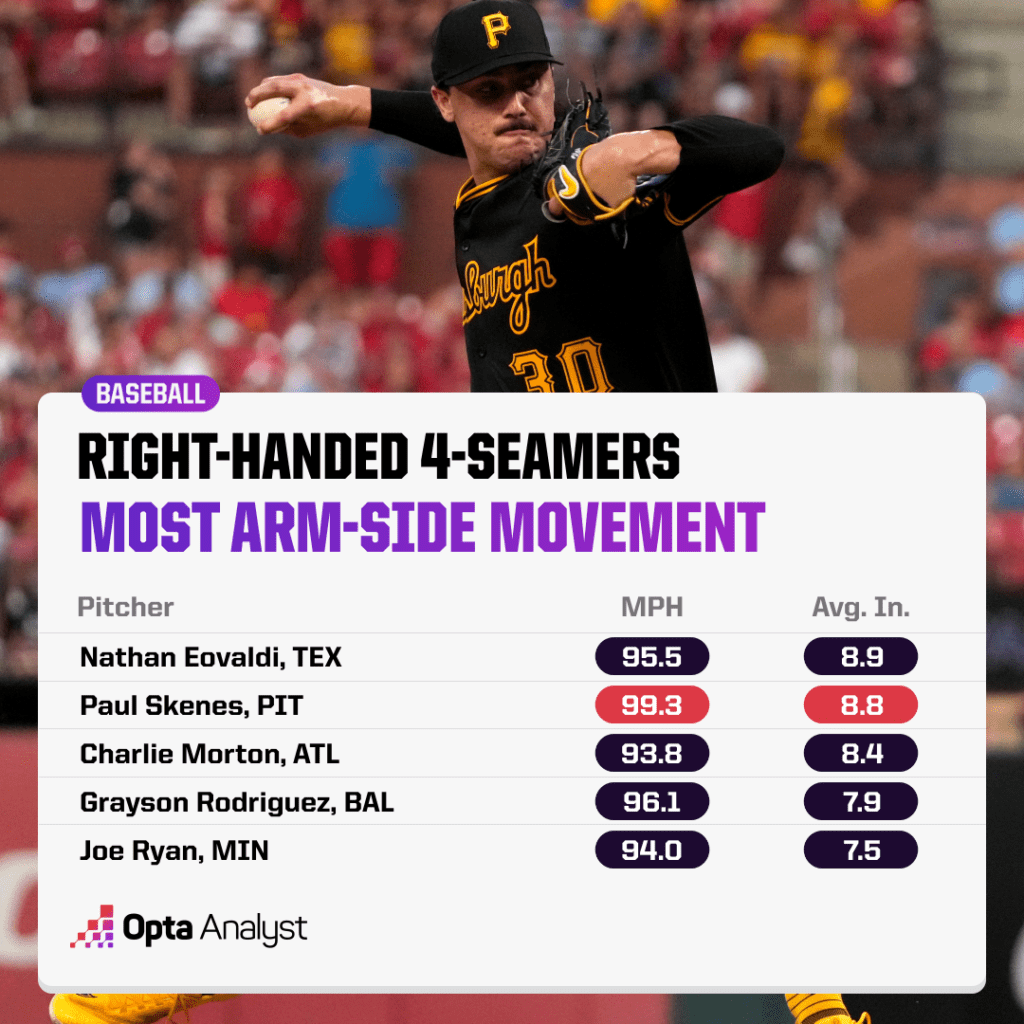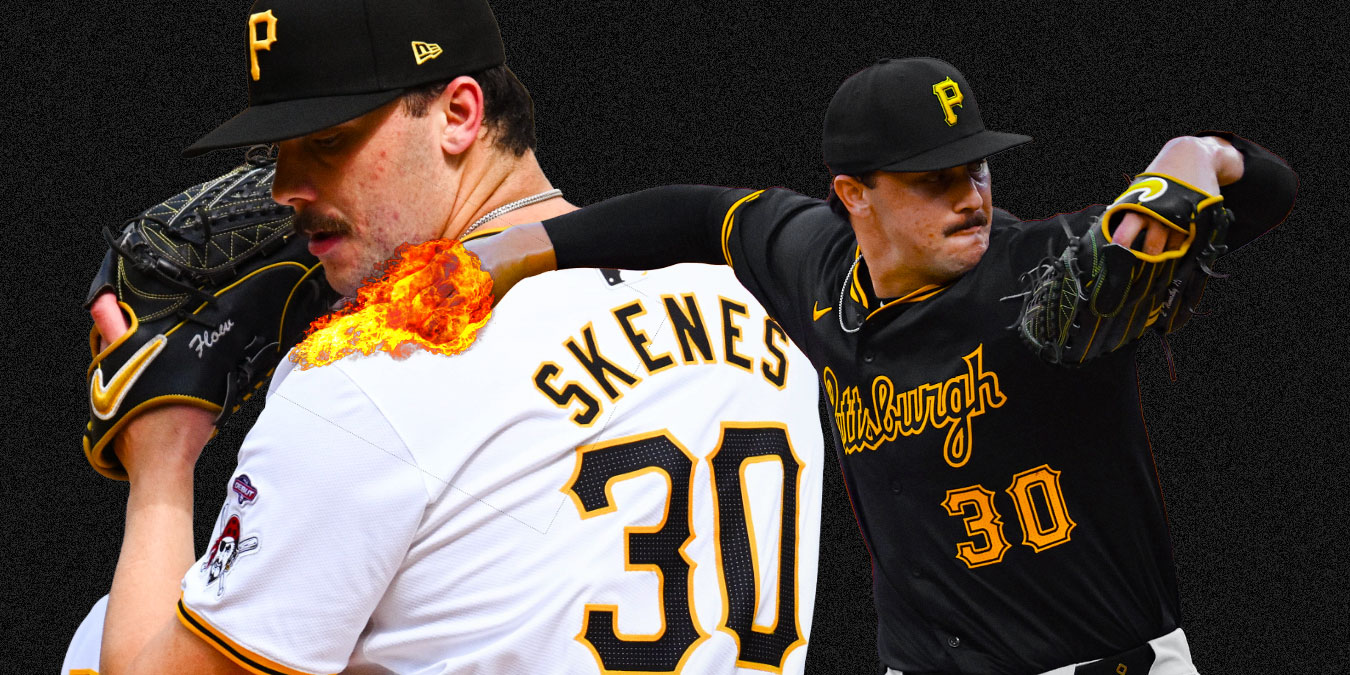Maybe the most incredible thing about Paul Skenes’ start? He’s still trying to figure out how to best utilize his entire repertoire.
Six starts into his MLB career, Paul Skenes is basically toying with big-league hitters.
The Pittsburgh Pirates phenom has struck out 46 of the 130 batters he’s faced. He’s thrown at least six full innings in four of his six starts and struck out at least seven batters in five of the six outings. In his second MLB start, he struck out 11 and didn’t allow a single hit against a Cubs lineup that had seen him just six days earlier.
Familiarity didn’t help the Chicago batters.
Maybe the most incredible thing? He’s toying with batters even though he’s still figuring how to use his toys.
“It’s cool to, with each outing, just learn how hitters are looking at my stuff and attacking me,” Skenes said after his last start in St. Louis.
Let’s take a look at that outing. Leadoff batter Mason Wynn was riding a hot streak heading into that first-inning at-bat against Skenes, with a .352 average and .920 OPS in his previous 23 games, to bring his season average up to .306. After three consecutive four-seamers – two in triple digits, one just below – painted the edges of the strike zone, Skenes dropped an 83.7 mph curveball on the outer third of the plate, right at the bottom of the zone.
Winn could only rock back, grimace, then walk back to the dugout.
In his first five starts, Skenes had captured the baseball world’s attention with his dynamic four-seam fastball, his nasty splitter — he calls it a “splinker,” kind of a hybrid between a splitter and a sinker — a slider/sweeper and regular appearances on Pitching Ninja’s Twitter feed.
Of his first 466 pitches in the bigs, he had thrown a total of 17 curveballs. Probably safe to say Winn was not expecting that molasses-slow (relatively speaking) breaking ball.
And, like the first three fastballs, it was painted. Seriously, check this out.
Halfway to home plate, the baseballs are basically in the same spot. The 100.2 mph fastball winds up at the top of the zone on the inner third; the 83.7 mph curveball winds up on the bottom of the zone, on the outer third.
Good luck, batters.
Just to show it wasn’t a one-time fluke of a pitch, Skenes used the curveball twice on the very next batter, Alex Burleson, who had four homers and a .953 OPS in his previous eight games. Both were strikes, one called and one swing-and-a-miss fishing expedition below the strike zone for the punch out.
“There have been different starts where we haven’t seen (the curveball) until later, but tonight he came out with the ability to use it, had a good feel for it,” Pirates manager Derek Shelton told Opta Analyst. “And the execution was outstanding.”
It most certainly was. And it wasn’t just his curveball. Skenes finished the night with eight strikeouts in 6.1 scoreless innings. He spread the wealth when it came to the pitches he used to get Ks. In order …
- 83.7 mph curveball (looking)
- 84.3 mph curveball (swinging)
- 95.4 mph splitter (swinging)
- 83.4 mph slider (swinging)
- 83.6 mph slider (swinging)
- 82.6 mph curveball (swinging)
- 99.2 mph four-seam fastball (swinging)
- 99.3 mph four-seam fastball (swinging)
That last strikeout fastball came on his 99th pitch of the game. Skenes’s average four-seamer this year checks in at 99.3 mph, which is far and away the hardest for any starting pitcher in the bigs. Dodgers youngster Bobby Miller is next at 98.3, followed by Hunter Greene at 97.6.
And what sets the Skenes four-seamer apart is the action, more horizontal movement with arm-side run than traditional backspin rise. That Skenes four-seamer averages 8.8 inches of arm-side movement.
There are several lefty starters with more – Chris Sale, Nick Lodolo, Kyle Harrison and Sean Manaea, to name a few – but among right-handed starters? Only Nathan Eovaldi (8.9) has more. And even though Eovaldi throws hard, of course, his average velocity of 95.5 is well below Skenes’ 99.3

“That’s because of his arm angle,” Pirates veteran Andrew McCutchen told Opta Analyst. “What he creates with his ball and his movement, it’s not gonna be like Jared Jones’ 100, it’s gonna look a little different. Once you’re able to put all that together at one time, it creates an illusion. It’s something that, I guess, guys aren’t used to really seeing.
“He has a shorter stride to the mound, so that makes the timing of the baseball a little tough to pick up and decipher. He’s just able to, to use that to his advantage, obviously. And he throws 100 with that arm angle as well, so there are a lot of things you’ve got to look at.”
Same thing with the splitter/splinker. The horizontal arm-side movement is elite (also 8.8), and the only pitchers who throws that pitch harder is closer Jhoan Duran (97.0).
Part of the Skenes learning curve is understanding that, even though these are big-league hitters, his stuff is nasty enough that he can focus on throwing strikes and not worry about his pitches getting hammered. In the first two innings against the Cardinals, Skenes needed just 23 pitches – 18 strikes, five balls – to dispatch all six hitters. The Cardinals didn’t get a hit until the fourth inning, and Skenes didn’t walk a batter all night.
Among all pitchers who have faced at least 130 batters, Skenes ranks fifth in MLB with a 140 whiff+ behind Garrett Crochet (153), teammate Jared Jones (151), Michael Kopech (145) and Reed Garrett (141). But what’s most impressive about that is he by far owns the best command+ of the group – 112 – well above the league average of 100.
But that doesn’t seem to matter much to the hard-throwing 22-year-old righty.
“I think ‘command’ is a little overblown. I think control is more how it actually goes, especially when you’re throwing hard,” he said. “Frankly, it’s kinda tougher to command pitches. So control, if that difference make sense. And (against the Cardinals), it was just more pitching in the strike zone. Being the type of pitcher I am, I’m just generally going to throw less strikes than a guy like (Miles) Mikolas is, probably.”
Skenes finished his outing at 103 pitches, 74 for strikes. Only 55 were actually in the strike zone, meaning he fooled Cardinals hitters (or the umpire) enough to chase 19 out of the zone. He generated 14 swing-and-misses, with only five pitches resulting in “hard hit” contact.
The pitch selection for Skenes, along with the pitches called by veteran catcher Yasmani Grandal, was different in the game. Skenes threw 20 curveballs – remember, he’d thrown only 17 total in his first five starts – 25 splitters/splinkers, 14 sweepers and one changeup. His fastest pitch was 100.2, and his slowest was 79.3.
It was yet another step in a direction that pleases the Pirates.
“We continue,” Shelton said in the understatement of the day, “to see growth out of Paul.”
Be sure to check out all our MLB, NBA, NHL and NFL coverage. And follow us on X and Instagram for more!
